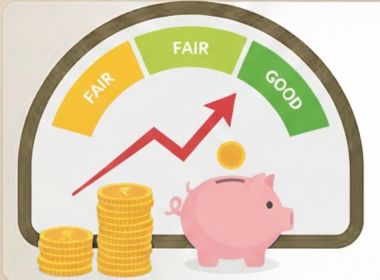Search Suggestions
- Gold Loan
- Money Transfer
- Mutual Funds

Flat vs Reducing Interest Rate: Which One Should You Choose?
Opting for a personal loan or any other loan type may feel like a simple exchange of funds for repayment with interest. However, what truly determines the repayment amount to the lending institution goes beyond just the loan amount and tenure. It is the way in which the interest is calculated that quietly streamlines the entire repayment journey for borrowers.
Table of Content
Among the most widely used repayment methods offered by the lending institutions are the flat interest rates and reducing interest rates; each comes with its own set of advantages and considerations, depending on the type of loan and repayment capacity.
The choice between flat vs reducing interest rates can influence your monthly budget, overall repayment structure and even how you plan your future finances. A flat interest rate simplifies the calculation by allowing you to pay interest on the loan principal throughout the tenure, making EMIs predictable. In contrast, reducing interest rate recalculates the interest on the outstanding balance every repayment, making your interest payments lower over time.
What is a Flat Interest Rate?
A flat interest rate is one of the straightforward ways to calculate how much interest you will pay to the lender until the tenure ends. Here, the lender charges interest on the entire principal amount throughout the loan tenure, regardless of how much principal interest you have already repaid. This means that even as your loan balance decreases with each installment, the interest is still being charged on the principal amount.
For instance, if you borrow INR 5,00,000 at a flat interest rate of 10% for 5 years, you will be paying interest of INR 50,000 each year, amounting to INR 2,50,000 in total interest, in addition to the principal repayment. A flat interest rate on a personal loan is ideal if the borrower has a steady source of income.
Ahead are the key advantages a borrower is entitled to if they choose a flat interest rate:
Simple and easy to understand
The calculation in a flat interest rate is transparent and straightforward, making it easier for the borrower to know exactly how much interest they are expected to pay each month.
Fixed repayment schedule
The monthly interest payment remains the same throughout the tenure, which helps in planning and managing monthly budgets without surprises or adjusting the budget each time.
Predictability for short-term loans
Since flat interest rates are often offered on loans with shorter tenures, like consumer durable loans or motor loans, the total repayment is easy to estimate and manage over the course of the loan term.
Ideal for specific borrower needs
For borrowers who prefer consistency and clarity in how they pay the interest amount over time, over fluctuating interest calculations, flat interest rates are an ideal choice.
Suggested Read: Step-by-Step Guide to Calculate EMI for a Personal Loan
What is a Reducing Interest Rate?
Unlike flat interest rates, where the monthly interest payment remains the same throughout the tenure, in reducing interest rates, the interest is calculated on the outstanding loan balance after each payment. As you continue to pay your monthly interest payments, the principal and the interest components adjust, with the interest portion reducing over time.
For instance, if you borrow INR 2,00,000 from a lending institution at a reduced interest rate of 10% for 5 years, your interest rate in the first year will be charged on the principal amount. However, in the second year, it will be charged on the reduced balance, say INR 1,00,000 and so on. This ensures that the overall interest paid is much less than the flat rate loan of the same terms.
Borrowers opting for a reducing or diminishing balance method have several benefits, which are as follows:
Cost-effective in the long run
Since the interest on reducing the interest rate is recalculated on the decreasing balance, borrowers pay less interest over the tenure compared to a flat rate loan.
Fair and borrower-friendly
The interest rate method aligns the interest charged with the actual outstanding balance, making repayment more efficient or borrower-friendly.
Flexibility for larger loans
Reducing interest rates is ideal for personal loans, home loans and business loans where the borrowed amount is significant, as the interest savings over the loan tenure are substantial.
Encourages faster repayment
Since the interest amount charged on a reducing interest rate on a personal loan or any other loan type is decreased with every installment, borrowers often feel motivated to manage loans better and close them earlier.
Suggested Read: Personal Loan Rejected? Try These Alternatives
Comprehending the distinction between flat vs. reducing interest rates can significantly impact your repayment journey and overall financial planning.
With flexible repayment plans and complete transparency, Muthoot Finance brings you decades of expertise in choosing the right interest type for you. From elucidating how personal loan interest rates affect your monthly interest payment to offering flexible products designed for your financial needs, Muthoot Finance ensures clarity, transparency and ease at every step, thereby fostering a confident and rewarding experience for every borrower.
- Instant Personal Loan
- EMI Calculator
- Document Required
- Track Personal Loan
- Interest Rate
- Procedure and Eligibility
CATEGORIES
OUR SERVICES
-

Credit Score
-

Gold Loan
-

Personal Loan
-

Cibil Score
-

Vehicle Loan
-

Small Business Loan
-

Money Transfer
-

Insurance
-

Mutual Funds
-

SME Loan
-

Corporate Loan
-

NCD
-

PAN Card
-

NPS
-

Custom Offers
-

Digital & Cashless
-

Milligram Rewards
-

Bank Mapping
-

Housing Finance
-

#Big Business Loan
-

#Gold Loan Mela
-

#Kholiye Khushiyon Ki Tijori
-

#Gold Loan At Home
-

#Sunherisoch
RECENT POSTS

Understanding KDM Gold and Why it’s Banned
Know More
Gold loan boom: 3,000 new branches to open in India in 12 months
Know More
Gold Loan Boom: Rs 14.5 lakh crore market spurs NBFCs to add 3,000 branches
Know More
How BNPL Affects Your Credit Score
Know More
Inside the Muthoot money machine: How a Kerala family turned gold loans into a billion-dollar empire
Know More
Billionaire Family Turns India’s Gold Obsession Into a Fortune
Know More
What is a Cheque and its Different Types in India?
Know More
Benefits of Paying Your EMIs on Time: Why Timely Payments Matter
Know More
A Complete Guide to Report Online Fraud
Know More
How does a Personal Loan Affect your Credit Score?
Know MoreFIN SHORTS

What Are Co-Pay and Deductibles in Insurance Policies?
Know More
Should You Take a Loan Against Your Mutual Fund or SIP?
Know More
Top 5 Best Mid-Cap Mutual Funds to Watch in 2026
Know More
Are Personal Loans Right for Retirees? Key Points to Consider
Know More
What Happens to a Personal Loan After the Borrower Dies?
Know More
Best Loan Choices for Credit Scores of 580 and Below
Know More
7 Reasons Why a Gold Loan Is the Best Option for Small Businesses
Know More
10 Reasons Why People in India Prefer Physical Gold
Know More
Real Estate vs Gold: Which Is a Better Investment in India?
Know More
10 Common Mistakes That Make Investors Lose Money in Mutual Funds
Know More
10 Reasons Why Gold Has So Much Appeal in Uncertain Times
Know More
7 Ways Settling Debt Can Impact Your CIBIL Score
Know More- South +91 99469 01212
- North 1800 313 1212


